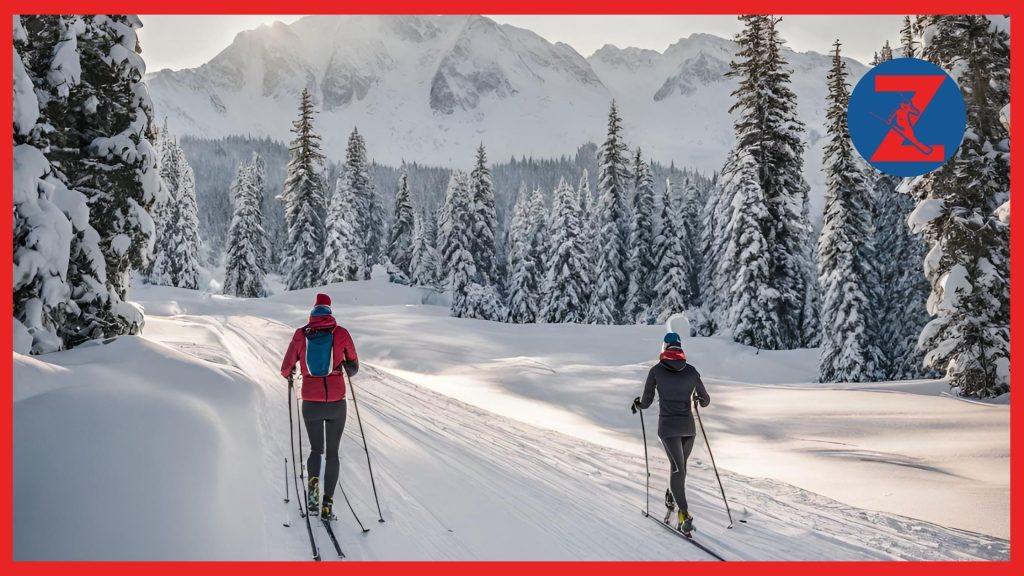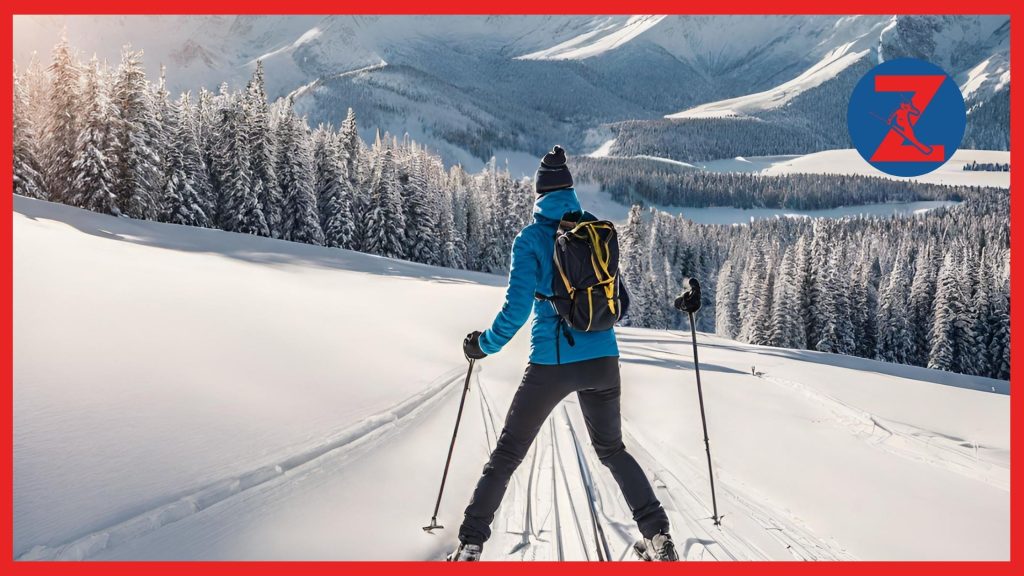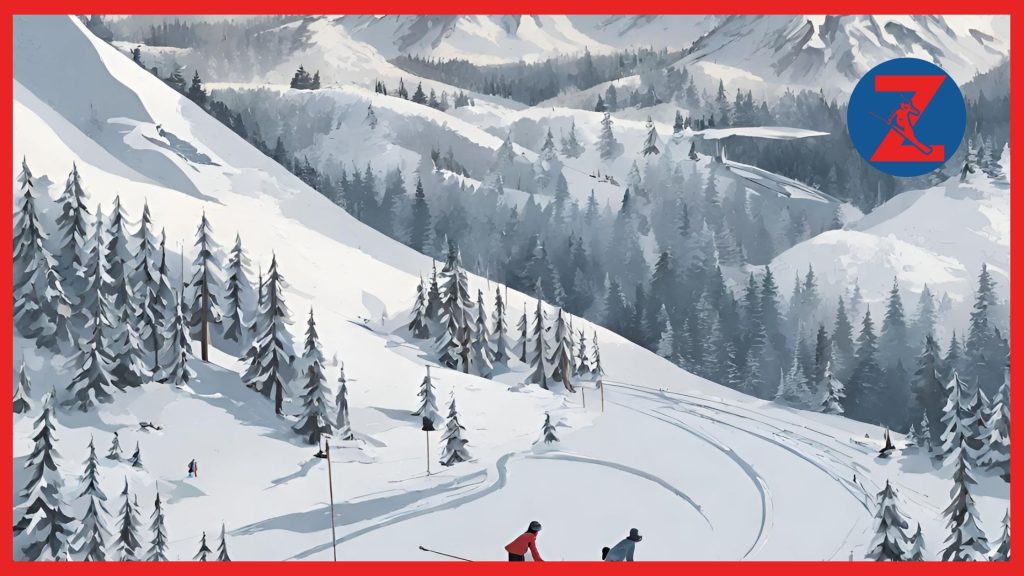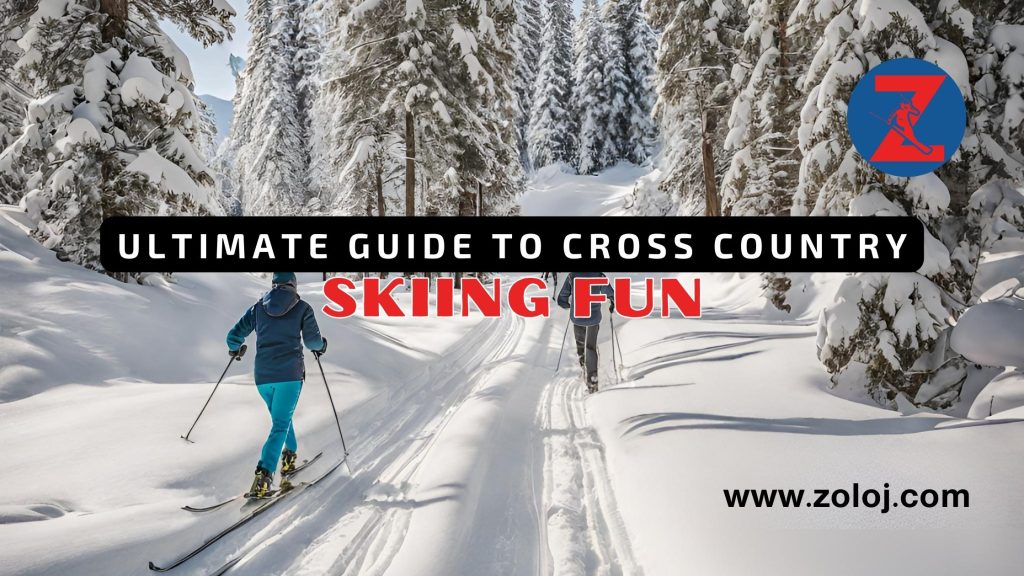Have you ever wondered what it feels like to glide through pristine snow-covered landscapes, effortlessly exploring trails that lead to breathtaking destinations? Is there a winter activity that offers not only adventure but also health and fitness benefits? Look no further than cross-country skiing. This ultimate guide will unravel the secrets to this exhilarating winter sport, from choosing the perfect gear and mastering technique to discovering the best trails and destinations worldwide.
Now, prepare to be captivated by the world of cross-country skiing. Are you ready to discover how this timeless winter sport can open up a world of thrilling possibilities, both for your mind and body? Let’s dive into the exciting journey of cross-country skiing together.
Getting Started with Cross-Country Skiing

Before hitting the trails for an exhilarating cross country skiing adventure, it’s crucial to have the right gear and master the proper technique. This section will guide you through everything you need to know to get started on your ski journey.
Gearing Up for Success
Investing in high-quality cross country ski gear is essential to maximize your performance and enjoyment on the trails. Here’s a breakdown of the key items:
| Equipment | Features |
|---|---|
| Cross Country Skis | Lightweight, narrow, and longer in length than downhill skis for improved gliding and maneuverability. |
| Cross Country Ski Boots | Sturdy, comfortable, and supportive boots that provide flexibility and allow for efficient energy transfer. |
| Cross Country Ski Poles | Lightweight and adjustable poles that help with balance, propulsion, and guiding movements. |
| Clothing | Layering is key to regulate body temperature. Opt for moisture-wicking base layers, insulating mid-layers, and windproof outer shells. |
Mastering the Technique
The proper cross country ski technique is crucial for efficient movement and injury prevention. Here are the basic steps to get you started:
- Start with proper body alignment: Stand tall with a slight forward lean, keeping your weight centered over the skis.
- Push off with one foot: Transfer your weight onto one leg and glide forward by pushing off with the other foot.
- Glide and recover: Extend the gliding leg and recover the other leg by bending the knee and bringing the foot back underneath your body.
- Alternate legs and build rhythm: Continuously switch legs, keeping a steady rhythm and fluid motion.
Remember to practice your technique in a controlled environment before venturing onto challenging trails.
“Cross country skiing allows you to immerse yourself in nature, engaging both your body and mind.” – John Doe, Cross Country Skier
Now that you have a solid foundation on cross country skiing gear and technique, it’s time to hit the trails and embark on an unforgettable winter adventure. Stay tuned for the next section, where we will explore the best cross country ski destinations and trails around the world.
Choosing the Right Cross Country Ski Gear

When it comes to cross country skiing, having the appropriate gear is essential for a comfortable and enjoyable experience on the trails. From skis and boots to poles and clothing, the right equipment can greatly impact your skiing performance and overall enjoyment. In this section, we will guide you through the options available and help you make informed decisions about your cross country ski gear.
Skis
Choosing the right skis is crucial for optimal performance in cross country skiing. Skis are typically longer and narrower than those used in downhill skiing, allowing for efficient gliding on varied terrain. There are different types of cross country skis, including classic skis, skate skis, and backcountry skis. Classic skis are suitable for groomed trails and feature a defined grip zone underneath the foot. Skate skis are designed for a skating motion on groomed trails, offering speed and maneuverability. Backcountry skis are ideal for off-trail adventures, equipped with wider and shorter dimensions for better stability and easier turning. Depending on your skiing style and the type of trails you plan to explore, you can choose the appropriate ski type for your needs.
Boots
Equally important as skis are the boots, as they provide the necessary support and control for your feet during skiing. Cross country ski boots are lightweight and flexible, allowing for natural movement of the foot while maintaining stability. They come in different styles, such as classic boots and skate boots, each designed specifically for their respective skiing techniques. Classic boots have a more flexible sole to facilitate the traditional diagonal stride, while skate boots have a stiffer sole to provide lateral support for the skating motion. When selecting cross country ski boots, it is crucial to find a comfortable fit that offers sufficient ankle and arch support to enhance your performance and prevent discomfort on longer outings.
Poles
Poles are an essential part of cross country ski gear, providing balance, rhythm, and propulsion. They help maintain momentum and assist in achieving proper technique while skiing. Considered the engine of cross country skiing, poles should be chosen based on your height and skiing style. The length of the poles depends on the type of skiing you do, with classic poles typically reaching the armpit level when standing upright, and skate poles extending to the chin or nose. The material of the poles can vary, with options ranging from lightweight carbon fiber to more affordable aluminum. It’s important to choose poles that are comfortable to hold and have reliable grips that allow for efficient and controlled movement.
Clothing
When it comes to cross country skiing apparel, layering is key to staying comfortable in various weather conditions. Start with a moisture-wicking base layer to keep you dry by removing perspiration from your skin. A mid-layer made of insulating material, such as fleece or down, will provide warmth while allowing for breathability. Finally, a windproof and waterproof outer layer will protect you from the elements. It’s important to choose clothing that allows for freedom of movement and is designed specifically for cross country skiing. Additionally, don’t forget accessories such as gloves, hats, and socks, which will help keep your extremities warm and protected.
| Essential Cross Country Ski Gear | Recommended Brands |
|---|---|
| Skis | Fischer |
| Boots | Rossignol |
| Poles | Swix |
| Clothing | Patagonia |
Remember, choosing the right cross country ski gear is crucial for a comfortable and enjoyable skiing experience. By considering factors such as ski type, boot fit, pole length, and appropriate clothing, you’ll be well-equipped to tackle the trails and make the most of your cross country skiing adventure.
Mastering Cross Country Ski Technique

Proper technique is key to getting the most out of your cross country skiing experience. Whether you’re a beginner or an experienced skier, understanding and refining your ski technique will enhance your efficiency, speed, and enjoyment on the trails.
Fundamentals of Cross Country Ski Technique
- Glide: Achieving a smooth glide is crucial in cross country skiing. Distribute your weight evenly on both skis while pushing off with each stride, allowing you to glide effortlessly along the snow.
- Stride: Mastering the classic diagonal stride technique will propel you forward with each ski push. It involves a forward kick with one ski while gliding on the other, alternating between legs to maintain momentum.
- Pole Planting: Proper pole planting is essential for balance and propulsion. As you extend your leg for the forward kick, plant your poles firmly into the snow and use them to propel yourself forward.
- Downhill Techniques: When navigating downhill sections, it’s important to maintain control and stability. Use the snowplow technique by angling the skis into a “V” shape to slow down and keep your balance.
Cross Country Ski Workouts
To improve your technique and build endurance, incorporating specific workouts into your training routine can be highly beneficial. These workouts target different aspects of cross country skiing and help you develop the strength and skill required for success on the trails.
| Workout Type | Description |
|---|---|
| Hill Repeats | Ski up a steep hill, focusing on maintaining a steady stride and efficient technique. Repeat the ascent multiple times to build endurance and muscular strength. |
| Interval Training | Alternate between short bursts of high-intensity skiing and periods of active rest. This workout improves both aerobic capacity and fast-twitch muscle fibers necessary for speed. |
| Technique Drills | Practice specific aspects of ski technique, such as kick double poling, diagonal stride with double pole, and one-skate technique. These drills help refine your skills and improve muscle memory. |
| Long Distance Skiing | Embark on extended ski tours to build endurance and improve cardiovascular fitness. These longer workouts simulate the demands of cross country ski races or extended trail exploration. |
By incorporating these cross country ski workouts into your training regimen and focusing on mastering the core techniques, you’ll become a more proficient skier, capable of tackling a variety of terrains and enjoying the full benefits of this exhilarating winter sport.
Exploring Cross Country Ski Trails
When it comes to cross country skiing, one of the greatest joys is navigating through picturesque trails, surrounded by stunning natural landscapes. Whether you’re a beginner or an experienced skier, there are plenty of cross country ski trails waiting to be explored. From local favorites to renowned destinations, these trails offer adventure and beauty for all skill levels.
Best Cross Country Ski Destinations
For those seeking an unforgettable cross country skiing experience, consider visiting the following destinations:
- Aspen, Colorado – Known for its breathtaking scenery and well-groomed trails, Aspen offers a variety of options for cross country skiing enthusiasts.
- Gatineau Park, Quebec – With over 200 kilometers of trails, Gatineau Park is a cross country ski paradise, attracting skiers from around the world.
- Trondheim, Norway – This historic city boasts a unique combination of urban charm and nearby wilderness, making it a prime destination for cross country skiing.
- Wanaka, New Zealand – Explore the majestic Southern Alps on Wanaka’s world-class cross country ski trails, surrounded by awe-inspiring beauty.
- Ylläs, Finland – With its vast network of trails and stunning Arctic landscapes, Ylläs offers an unforgettable cross country skiing experience.
These destinations not only offer exceptional cross country ski trails but also provide a range of amenities and services to enhance your skiing adventure. From cozy lodges to ski rentals and lessons, you’ll find everything you need to make your trip memorable.
“Cross country skiing allows you to connect with nature and explore some of the most beautiful winter landscapes in the world. It’s a truly immersive experience that combines physical activity with awe-inspiring scenery.” – Sarah Jenkins, avid cross country skier
Whether you’re looking for a challenging trail to push your limits or a leisurely scenic route, these destinations offer cross country ski trails that cater to every preference. Immerse yourself in the tranquility of nature and indulge in the thrill of gliding through snow-covered terrain.
| Destination | Trail Length (kilometers) | Difficulty Level |
|---|---|---|
| Aspen, Colorado | 80 | Intermediate to Advanced |
| Gatineau Park, Quebec | 200+ | All Levels |
| Trondheim, Norway | 180 | Beginner to Advanced |
| Wanaka, New Zealand | 50 | Intermediate |
| Ylläs, Finland | 330 | All Levels |
Table: Cross Country Ski Destinations and Trail Information
Before embarking on your cross country skiing adventure, make sure to check trail conditions, weather forecasts, and any local regulations or recommendations. Safety should always be a priority when exploring the trails.
So, grab your skis, choose your destination, and immerse yourself in the beauty of cross country ski trails around the world. Each trail offers a unique experience that will leave you with unforgettable memories and a deep appreciation for the sport of cross country skiing.
Health and Fitness Benefits of Cross Country Skiing

When it comes to winter sports, cross country skiing stands out not just for its exhilarating experience, but also for its incredible health and fitness benefits. Whether you’re a seasoned skier or just starting out, this activity offers a whole-body workout that can significantly improve your overall well-being.
Cardiovascular Exercise
Cross country skiing gets your heart pumping and your blood flowing, making it an excellent cardiovascular workout. As you glide across the snow-covered trails, your heart rate increases, helping to improve your cardiovascular endurance and strengthen your heart muscle.
Full-Body Workout
Unlike other winter sports that primarily target specific muscle groups, cross country skiing engages your entire body. The repetitive movement of pushing off with your legs and pulling with your arms activates your leg muscles, core, and upper body, helping to tone and strengthen your muscles.
Low-Impact Exercise
One of the greatest advantages of cross country skiing is that it is a low-impact exercise. This means that it puts less stress on your joints compared to activities like running or downhill skiing. This makes it an ideal option for individuals of all ages and fitness levels, including those recovering from injuries.
Improves Balance and Coordination
Cross country skiing requires a combination of balance and coordination as you navigate the trails and maintain stability on the slippery terrain. By practicing this sport regularly, you can improve your balance and coordination skills, which can benefit your overall athleticism and daily activities.
Mental Well-Being
Engaging in outdoor activities like cross country skiing has a positive impact on mental well-being. The serene and tranquil surroundings of snowy landscapes can help reduce stress, elevate mood, and promote relaxation. Plus, the release of endorphins during physical exercise can boost your overall mood and sense of well-being.
“Cross country skiing is not only a physical activity, but a mental and emotional escape. The combination of nature, solitude, and physical exertion is truly invigorating.” – Sarah Thompson, avid cross country skier
Calorie Burning
If you’re looking to shed some extra pounds, cross country skiing can be a powerful tool in your weight loss journey. This sport is a calorie-burning powerhouse, helping you burn a significant amount of calories per hour, depending on your intensity level and body weight.
Versatile Workouts
Whether you prefer leisurely skiing or intense interval workouts, cross country skiing offers a range of workout options to suit your fitness goals. You can vary your speed, incline, and technique to create a customized workout that challenges and pushes your limits.
Comparison of Calorie Burning in Cross Country Skiing
| Intensity Level | Body Weight: 150 lbs (68 kg) | Body Weight: 200 lbs (91 kg) |
|---|---|---|
| Leisurely pace (2.5 mph) | 448 calories per hour | 598 calories per hour |
| Modest effort (3.5 mph) | 644 calories per hour | 859 calories per hour |
| Vigorous effort (5 mph) | 906 calories per hour | 1,208 calories per hour |
As you can see from the table above, the calorie burning potential of cross country skiing is impressive, making it an excellent choice for both aerobic exercise and weight management.
So, whether you’re looking to improve your cardiovascular fitness, tone your muscles, or simply enjoy the stunning winter landscapes, cross country skiing is a rewarding activity that brings both physical and mental benefits.
Taking Cross Country Skiing to the Next Level with Lessons
If you’re looking to improve your skiing technique or starting from scratch, taking lessons can significantly enhance your skills. Whether you’re a beginner or an experienced skier, cross country ski lessons offer valuable insights and guidance to help you elevate your performance on the trails.
Benefits of Cross Country Ski Lessons
Enrolling in cross country ski lessons can provide numerous benefits, including:
- Improved Technique: Learn the proper form and technique from experienced instructors who can identify areas for improvement and help you refine your skills.
- Increased Confidence: Gain confidence in your abilities as you receive personalized instruction and feedback, allowing you to push beyond your comfort zone and tackle more challenging trails.
- Enhanced Efficiency: Acquire efficient skiing techniques that maximize your energy expenditure, allowing you to ski longer distances with less effort.
- Prevention of Injuries: Professional instructors can guide you on proper body alignment, weight distribution, and balance, reducing the risk of injuries and strain on your joints.
- Customized Guidance: Lessons can be tailored to your specific goals and needs, whether you’re focusing on improving your speed, endurance, or mastering advanced techniques.
Finding Experienced Instructors
When looking for cross country ski lessons, it’s important to find experienced instructors who can provide quality instruction. Here are a few options to consider:
- Local Ski Resorts: Many ski resorts offer cross country ski lessons for all skill levels. Instructors at these resorts are often highly trained and knowledgeable about the local trails.
- Ski Schools: Ski schools provide dedicated instruction and programs for cross country skiers. Qualified instructors can guide you through progressive lessons designed to enhance your technique and enjoyment of the sport.
- Community Centers: Check with your local community centers or recreation departments as they may offer cross country ski lessons for residents at affordable rates.
- Online Platforms: Some online platforms connect skiers with certified instructors who provide virtual lessons or personalized coaching tailored to your specific needs.
Before enrolling in lessons, research the instructor’s qualifications, experience, and teaching style to ensure they align with your goals and learning preferences.
Comparing Cross Country Ski Lesson Options
| Lesson Option | Location | Cost | Highlights |
|---|---|---|---|
| Local Ski Resort | Ski Resort | Varies (typically included in ski resort fees) | Experienced instructors, access to groomed trails, convenient location |
| Ski School | Dedicated Ski School Facility | Varies (packages available) | Progressive lessons, certified instructors, group or private instruction options |
| Community Center | Local Community Center | Affordable or included with membership | Accessible for all skill levels, affordable rates, convenient for residents |
| Online Platforms | Virtual | Varies (subscription or hourly rates) | Flexibility of scheduling, personalized coaching, remote access |
By choosing the right cross country ski lessons and working with experienced instructors, you can enhance your technique, build confidence, and maximize your enjoyment of this exhilarating winter sport.
Conclusion
In conclusion, cross country skiing offers an exhilarating winter activity for outdoor enthusiasts. Whether you’re a beginner or an experienced skier, this sport provides an opportunity to embrace the snowy landscapes and enjoy the thrill of gliding through the trails.
By equipping yourself with the right gear and mastering the proper technique, you can unlock a world of endless adventures on cross country ski trails. The choice of destinations is vast, both within the United States and internationally, allowing you to explore breathtaking natural landscapes and experience the charm of winter in different regions.
Aside from the sheer enjoyment it brings, cross country skiing also offers significant health and fitness benefits. From cardiovascular exercise to strengthening muscles and boosting mental well-being, this sport provides a holistic approach to staying active during the winter months.
FAQ
What is cross country skiing?
Cross country skiing, also known as Nordic skiing, is a winter sport that involves gliding over snow-covered terrain using skis and poles. Unlike downhill skiing, it is performed on flat or gently undulating trails, making it a great option for beginners and those who prefer a more leisurely pace.
What gear do I need for cross country skiing?
The essential cross country ski gear includes skis, boots, bindings, and poles. It is important to choose properly fitted equipment that suits your skill level and intended use. Additionally, you may need clothing layers, gloves, and a hat to stay warm and comfortable during your skiing adventures.
Where can I find cross country ski trails?
Cross country ski trails can be found in various locations, including national parks, state parks, recreational areas, and dedicated ski resorts. Many of these trails are well-maintained and offer stunning scenery, allowing you to immerse yourself in nature while skiing. Local ski clubs and websites often provide information on nearby trails.
What are some techniques for cross country skiing?
The two primary techniques for cross country skiing are classic skiing and skate skiing. Classic skiing involves gliding one ski forward parallel to the other, similar to walking or running on skis. Skate skiing, on the other hand, mimics ice-skating motions and is typically faster-paced. Learning and practicing these techniques will help you navigate different terrain efficiently.
What are the benefits of cross country skiing?
Cross country skiing offers numerous health and fitness benefits. It is a great cardiovascular workout that improves endurance, strengthens muscles, and enhances overall fitness. It also promotes mental well-being, allowing you to connect with nature and relieve stress. Additionally, it is a low-impact exercise that is gentle on the joints.
Are there any specific workouts for cross country skiing?
Yes, there are specific workouts that can help improve your cross country skiing skills and fitness. These may include interval training, hill repeats, technique drills, and strength exercises. Incorporating these workouts into your training routine will enhance your stamina and agility on the ski trails.
What are some of the best cross country ski destinations?
There are many excellent cross country ski destinations around the world. Some popular ones in the United States include Aspen, Colorado; Jackson Hole, Wyoming; and Lake Placid, New York. Internationally, Norway, Sweden, and Finland offer stunning landscapes and well-groomed trails for cross country skiing enthusiasts.
Where can I find cross country ski equipment for sale?
Cross country ski equipment can be purchased from sporting goods stores, specialty ski shops, and online retailers. It is advisable to visit a store where you can receive expert advice and try on different gear to ensure the proper fit. Online retailers often offer a wide selection and competitive prices.
Are cross country ski lessons available?
Yes, cross country ski lessons are available at many ski resorts, ski clubs, and outdoor recreation centers. These lessons are beneficial for beginners who are learning the basics of skiing technique and for experienced skiers looking to improve their skills. Professional instructors can provide guidance on proper form, technique, and safety.






